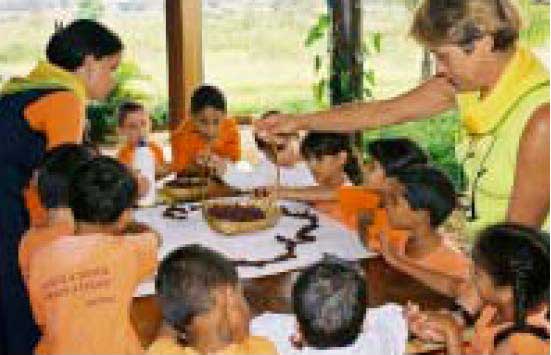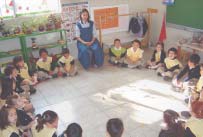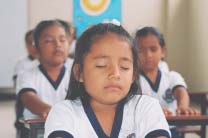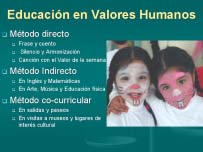Chapter 8ACHIEVEMENTS OF SATHYA SAI EDUCATION
Man must either know the Supreme Truth of the One Being behind all becoming, the goal. —Sri Sathya Sai Baba |
Table of contents return to Front page |
|
Sri Sathya Sai Baba says that though acquisition of worldly knowledge is important and beneficial to children growing up, they also need to be assisted in the development of good character traits by bringing out the five human values that are considered an expression of spirituality.The assertion that the human purpose is fulfilled through spirituality and that character development should be a key component in education practices carries profound implications for society. His teachings in this regard have led to the development of a range of formal, non-formal, and informal educational programmes, which are collectively referred to as Sathya Sai Education. The programmes have been described in detail in earlier chapters.  Brazil
|
From its early beginnings in India in the late 1960s, Sathya Sai Education has spread to all parts of the world and is practiced by educationists in diverse cultural settings. This chapter presents results of a comprehensive assessment of programme achievements conducted by the Education Committee of Sri Sathya Sai World Foundation in 2006. Data were collected from all 95 countries where Sathya Sai Educational Programmes are currently implemented. Included are research reports from the Institutes of Sathya Sai Education, as well as the results of independent appraisals of Sathya Sai Schools made by governmental education agencies and by universities. Additionally, the assessment has drawn upon the vast wealth of anecdotal evidence that comes from students, ex-students, teachers, and parents who participated in these educational programmes.  Mexico |
Reports by School Inspectors and
|
|
|
This is a distinctive school that is successful in achieving its aims. It provides a secure spiritual environment in which pupils can learn and make good progress. ... Pupil's personal development is a very strong feature of the school and it is conspicuously successful in promoting its philosophy. The SSEHV programme is central to the life of the school. It manifests itself through the daily devotions, with the teachers acting as good role models and constantly linking all aspects of the curriculum to the values of the SSEHV programme ... The SSEHV programme is instrumental in pupils developing confidence and in raising their self-esteem. Pupils are valued as responsible citizens. They learn to be confident through such roles as leading the singing at assemblies and helping younger pupils. —Report by an inspector of OFSTED (UK), November 2004 |
Institutes of Sathya Sai EducationStudents who participate in the Diploma and other programme of the ISSEs regularly report amazing transformations in themselves. Jumsai (2003) has given an excellent account of such transformations. Here is a statement made by a Swedish student. I got motivation and inspiration to go on with my studies to become a teacher. Prior to my stay in Lobpuri I felt that the education system was dry and solely academic. I had not seen the spiritual part of life being practiced and felt in the educational field before I came to the Sathya Sai School. This absence of values had made men discouraged about getting a degree in teaching. The course in Human Values Education in Lobpuri changed that. —A student from Sweden after attending a Diploma Course in ISSE-Thailand The quality of programmes in some ISSEs has been recognised by the local universities as at par with their own standards for post-graduate courses. For example, the Diploma and the Advanced Diploma of ISSE in Australia and the Philippines are accepted for transfer of credits at postgraduate degree level in universities. |
Independent Evaluation by the United NationsSince 2001, the Institute of Sathya Sai Education in Africa (ISSE-Africa) has been assisting the United Nations (UN-HABITAT) in implementing a Human Values-based Water Education Programme in Africa. The programme covered six African countries in the first phase and was implemented in partnership with the ministries of education in these countries. Details of this programme are given in Chapter 7. An independent evaluation of the Phase I of the programme conducted by the United Nations in late 2004 reports as shown in the box below: |
|
Indeed, the evaluator believes the Value-based Water Education Programme (VBWE) to be a necessary one because of the breakdown of traditional behaviour and erosion of values over much of Africa and because of the seriousness of the water crisis. Nor, as has been pointed out by many, are human values foreign to most African countries. In fact they are inherent in the African tradition. And when confronted with their existence and significance most stakeholders readily agree that their adoption is a necessary condition for a return to responsible behaviour on the part of all in society. The project has clearly captured the imagination not only of those participating in Phase 1 itself but also of those cities and countries that have since been informed about its inception and progress. In this context, note should be taken of the great interest shown by countries in other regions of the world. The evaluator was fortunate in being able to attend the recent SEAMEO-UNESCO Education Congress in Bangkok. At this Congress one of the topics was VBWE including a session entitled "Africa-Asia Meet Forum" where African delegates were able to share experiences with their fellow delegates from Asian countries. The resultant discussion testified to the intention of such countries (and others) to place VBWE as a central plank in their future educational and water and sanitation activities. —From the Evaluation Report by Prof. Norman Clarke, Independent Evaluator, United Nations, Sept. 2004 |
NON-FORMAL EDUCATION PROGRAMMESObservational research from a variety of sources indicates that children become more open and confident, and able to share their feelings after they join Bal Vikas/Sai Spiritual Education (SSE) or SSEHV classes.Their attitudes and behaviour improve as found in the following research data gathered from a survey conducted through questionnaires in a sample of 65 former SSE students (Paramsothi, 2006). The researcher observed: "The vast majority of children attended SSE classes because they found the lessons interesting, and they seldom missed a class. They found the course content relevant, and that the teachers enhanced their motivation and were ever ready to help them. SSE equipped them to deal with life challenges in later life, and they would recommend the programme to others. Further, the vast majority of children with these views noted that SSE had motivated them to engage in community service activities." The researcher concluded that SSE develops better capacities in the children to:
|
If a question is put, what is education? People say, it is the acquisition of knowledge. But it is not merely acquisition of knowledge; it must be in action. What is the end of education? Character is the end of education. What is the essence of education? Concentration is the essence of education. What is the aim of education? The aim of education is not only cultivating human qualities, but attaining divinity. Education is meant for life, not for living. —Sri Sathya Sai Baba
Similar studies conducted in the UK show that where a more structured SSE programme is in place, the level of benefits derived by the children is notably high. Some of the teaching methods used have contributed toward academic development and an increase in self-confidence and self-reliance. SSE programmes have strengthened the commitment of teachers and parents to live the five human values in daily life. Parents and teachers are aware of the need to cultivate harmony of head, heart, and hand (3HV) for their own spiritual progress. Teachers have reported the personal benefits gained from teaching the SSE programme. They see it as an important opportunity for personal spiritual growth, as well as an opportunity for serving the community. Many of the ex-SSE children have completed full-time education and are now working in various fields, such as medical, accountancy, engineering, public relations, teaching, marketing, and information technology. |
 Ecuador
|
 Chile |
Testimonials from Former SSE StudentsSelf-evaluative statements by former students of SSE and Bal Vikas programmes indicate that they are more tolerant, have greater ability to handle negative thoughts, and are more willing to serve others. The following statements are typical of the hundreds of such testimonies from students around the world.
|
|
Impact of SSE and SSEHV on the TeachersSSEHV proves effective when presented with warmth and sincerity, and with an understanding of the emotional and spiritual aspects of the programme. The programme takes little time to connect with the target audience, and frequently there is enormously positive response when presenting the programme to newcomers. While dedicated and consistent effort on the part of the teachers is required, the positive results obtained appear to more than justify the time and effort actually expended. To witness the results achieved by volunteers has often proved to be more convincing evidence to professional teachers of the benefits of SSEHV than any academic treatise on the programme might provide. It often motivates professional teachers to investigate further and adopt SSEHV themselves. Research (Marantz, 1991) conducted in a variety of public schools and settings in the U.S.A. — in New York, Chicago, and in San Diego involving fourteen schools, |
sixty teachers, and 1,500 students from a variety of backgrounds, demonstrated that SSEHV could be integrated and implemented in formal academic settings in public (government) schools.Teachers and administrators found the SSEHV model of integrating human values and character development to be of exceptional value. Sri Sathya Sai Baba always emphasizes that the teachers need to be exemplars and to demonstrate by their own behaviour that they think what they say, and they do what they teach. The Sri Sathya Sai Organisation encourages that the teachers not only receive high quality standardised training, but they also implement the human values into their own lives. Accordingly, teachers themselves gain great spiritual benefit by their participation in the programme. Below are some testimonies from teachers. |
|
|
Impact of SSE and SSEHV on Parents of the StudentsThere are many indications that the positive impact these programmes have on students often transfers to their parents. The perception by parents that favourable changes are taking place in their children frequently results in a positive change in relationships at home. Many parents report that their children have become more respectful, more appreciative, less wasteful, and more inclined to take responsibility for themselves and their home. They also watch less TV and use softer speech. Noticing these changes, the parents tend to develop a more positive regard for their children. Jumsai (2003) reports that parents become more loving, help their children with their homework, begin to interact with the teachers, incorporate human values into their own life, and improve their social behaviour. In a correctional institute for minors in Monterrey, Mexico, devotees started giving human values classes, once a week, to the inmates who are children from 12 years to 17 years of age. Then they had the idea to give the Sai Parenting Programme to the parents of the inmates. The results were amazing. When one parent started to open up and talk of all his problems, others joined in, and they found they were all facing the same types of problems which they did not want their children t repeat. The relationship between parents and children improved significantly. The governor of the State of Monterrey sent a letter of appreciation and a certificate of commendation to the Sri Sathya Sai Organisation for this outstanding contribution to the society. |
Impact of Sathya Sai Parenting Programme on ParentsThere are several dedicated Sathya Sai parenting resources (Dhall and Dhall 1999, 1999a, 1999b; Bruce, 2001; Jareonsettasin, 1998). One of these resources has been made into a structured programme for parents (Dhall and Dhall, 1999) that has been in use in many countries now for several years. It is currently being formally evaluated for its effectiveness through research. Research findings on the Sathya Sai Parenting programmes (Bilimoria, 2006) indicate a highly significant positive and lasting effect on the family health and attitudes in parents who attended the programme.This is especially evident when the programme is delivered by skilled facilitators and the initial programme is followed up with subsequent workshops.There are many stories and anecdotes of family reconciliations - between the spouses and between alienated youth and the parents. There are even anecdotes of recovery from addictions after attending a SSEHV programme for the parents as illustrated by the following example from Mexico: |
|
In a correctional institute for minors in Monterrey, Mexico, devotees started giving human values classes, once a week, to the inmates who are children from 12 years to 17 years of age. Then they had the idea to give the Sai Parenting Programme to the parents of the inmates. The results were amazing. When one parent started to open up and talk of all his problems, others joined in, and they found they were all facing the same types of problems which they did not want their children t repeat. The relationship between parents and children improved significantly. The governor of the State of Monterrey sent a letter of appreciation and a certificate of commendation to the Sri Sathya Sai Organisation for this outstanding contribution to the society. |
References
Ayyagari, P., (2006), Personal Communication. Masters Thesis in progress, ISSE, Australia.
Bilimoria, D., (2006), An Assessment of Sathya Sai Parenting Program, Advanced Diploma Thesis, ISSE, Australia.
Blatchford, R., (2004), Advanced Diploma, A Case Study: EHV Program in Cherbourg State School, Advanced Diploma Thesis, ISSE, Canberra , Australia.
Bruce, R., (2001), Sathya Sai Parenting, Sathya Sai Books and Publications Trust, Puttaparthi, India.
Dhall, D. P. and Dhall T. Z., (1999),
Dynamic Parenting: Education in Human Values for Parents, Based on the Teachings of Sri Sathya Sai Baba,
Global Service Publishing,
Puttaparthi, Andhra Pradesh, India.
Dhall, D. P. and Dhall T. Z., (1999a), Human Values: the Heart of Dynamic Parenting, Global Service Publishing, Puttaparthi, Andhra Pradesh, India.
Dhall, D. P. and Dhall T.Z., (1999b),
Workshops in Human Values: the Heart of Dynamic Parenting for Trainers and Facilitators,
Global Service Publishing, Puttaparthi, Andhra
Pradesh, India.
Emmons, R. A., (2000), Is Spirituality an Intelligence? Motivation, cognitive and psychology of ultimate concern.
International Journal for the Psychology of Religion,
10: 3 - 26.
Foa, C., (2006), An Assessment of the EHV Program in the Sathya Sai School in Australia. Advanced Diploma Thesis, ISSE, Canberra, Australia.
Gardner, H., (1999), Intelligence Reframed, Multiple Intelligence for the 21st century, Base Books, New York, USA.
Jareonsettasin,T., (1998), Sathya Sai on Parenting, Institute of Sathya Sai Education, Bangkok, Thailand.
Jumsai, A., (2003), A Development of the Human Values Integrated Instructional Model Based on Intuitive Learning Concept, Chulalongkorn University, Bangkok,Thailand.
Kumar, S., (2006), Values Education: Teacher Attitudes and Awareness. Advanced Diploma Thesis, ISSE, Canberra, Australia.
Lerner, R. M., (2006), Handbook of Child Psychology. Vol I. Theoretical Models of Human Development, eds. Damon, W. and Lerner, R.M., John Wiley & Sons Inc., Hoboken,
New Jersey, USA.
McNaught, K., (2005), Practising Unity of Head, Heart and Hand. Advanced Diploma Thesis, ISSE, Canberra, Australia.
Madhavi, M., (2000), Paper presented at The Association of Moral Education, International Conference, 7- 11 July 2000, University of Glasgow, Glasgow.
Marantz, R., (1991) Doctoral Dissertation,
An Analysis of the Implementation of a Curriculum Innovation for Character Development: Sathya Sai Education in Human Values,
Teachers College, Columbia University, New York, USA
Paramsothi, V., (2006), An Evaluation of the Sai Spiritual Education Program Group 3, Advanced Diploma Thesis, ISSE, Canberra, Australia.
Pargament, K.I., (1999), The Psychology of Religion and Spirituality? Yes and No, International Journal for the Psychology of Religion, 9: 3-14.
Ritchie, I., (1998), Improving the Ethos of a School and Achieving Academic Excellence: The Sathya Sai Education in Human Values Approach: an action research, Paper
presented at the Scottish Educational Research Association (SERA), Annual Conference (September 24-26 1998, University of Dundee).
Seligman, M., (2002), Authentic Happiness : Using Positive Psychology to Realize Your Potential for Lasting Fulfilment, Random House, Sydney, Australia.
Seshadri, H. and Harihar, S., (2004), Educare for Parents, Teachers and Students, Sathya Sai Books and Publications Trust, Puttaparthi, Andhra Pradesh, India.
Sharma, D.P., (2005), Sathya Sai Centres as Spiritually Transforming Agents, Advanced Diploma Thesis, ISSE, Canberra, Australia.
Zinnbauer, B. J., Pargament, K. I., Cole, B., Rye, M. S., Butter, E. M., Belavich, T.G., Hipp, K. M., Scott, A. B. and Kadar, J. L., (1997), Religion and Spirituality: Unfuzzying the
fuzzy,
Journal of Scientific Study of Religion,
36: 559-64.
Zohar, D., and Marshall, I., (2000), (paper edition 2001), Spiritual Intelligence the Ultimate Intelligence, Bloomsburg Publishing, New York, USA.